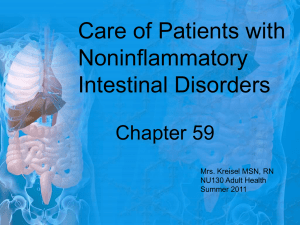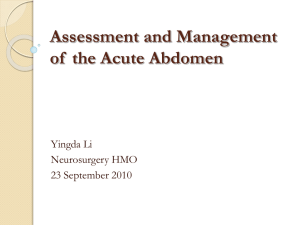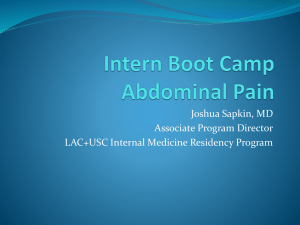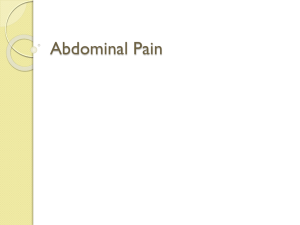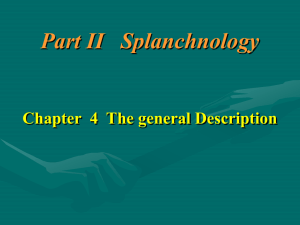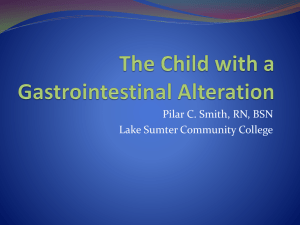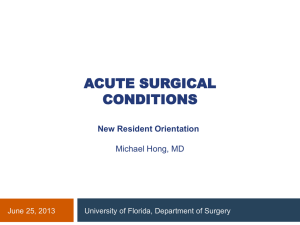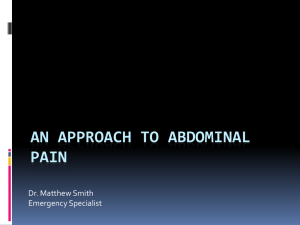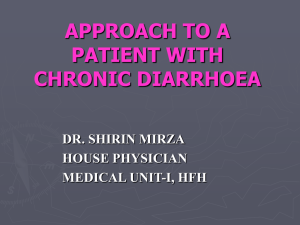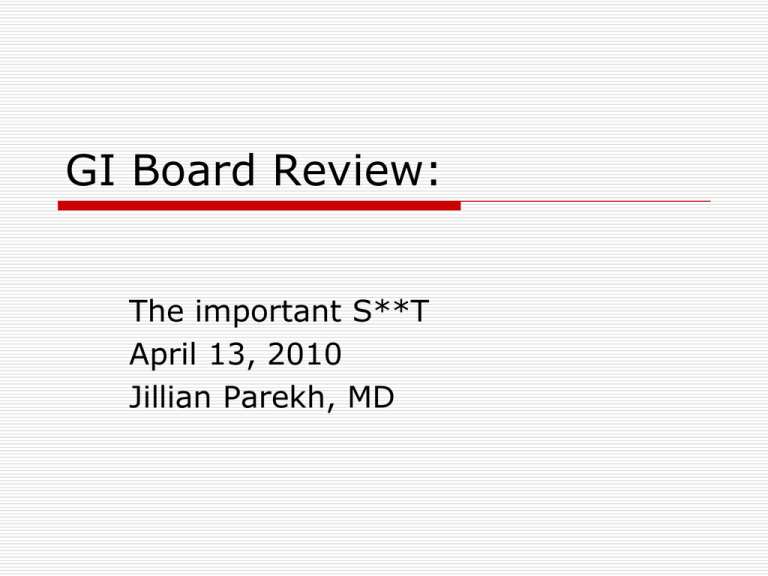
GI Board Review:
The important S**T
April 13, 2010
Jillian Parekh, MD
Question:
A 12 y/o F presents to the ED with abdominal pain.
Her parents report that she awakened with a temp of
101 this am, c/o abdominal pain, and has vomited
twice. Denies diarrhea, and there are no sick
contacts. She reports nausea and no interest in food
or drink. She was previously healthy. UA shows SG
1015, otherwise normal.
Of the following, the finding that MOST indicated the
need for immediate surgical intervention is:
A. Abdominal distention
B. Hyperactive bowel sounds
C. Pain in the right lower quadrant
D. Rigidity of the abdominal wall
E. Voluntary guarding
Answer:
A. Abdominal distention
B. Hyperactive bowel sounds
C. Pain in the right lower quadrant
D. Rigidity of the abdominal wall
E. Voluntary guarding
Explanation:
Abdominal tenderness can occur in children with
nonsurgical abdomens and those with peritoneal
inflammation
Presence of bowel sounds is usually reassuring
Simple abdominal distention may occur with non
surgical causes of abodminal pain
RLQ pain is suggestive when other signs of peritonitis
are present, but can also occur in other processes
(ovarian, AGE)
Voluntary guarding is common on exam, esp with
children
Distention with tenderness, rigidity of the abdominal
wall to palpation are more specific signs of peritoneal
irritation surgical abdomen
Appendicitis:
Child > 2 usually
Acute RLQ, periumbilical or
midepigastric abdominal pain –
classically McBurney’s point
Associated with nausea, vomiting,
anorexia, low grade fever
Xray findings: sentinel loop, absence
of air in the RLQ
NSAID induced dyspepia
NSAIDs inhibit cyclooxygenase (COX)
COX needed for prostaglandin
synthesis
Prostaglandins protect the gastric
lining
If they describe a patient with
rheumatoid condition p/w epigastric
pain…think NSAIDs.
Frequent causes of acute pain:
Constipation
Adenitis
Mono
Pancreatitis
Hepatitis
Infection (UTI)
Trauma
Recurrent or chronic pain:
3 or more episodes of abdominal pain
in more than 3 months
Pain must be severe enough to
interrupt normal activity
On the boards, think of psych factors
Encorporesis
LLQ pain with a palpable mass on
exam
School aged child, soils pants, denies
diarrhea, no systemic complaints
Treatment:
Education (avoid blame)
Emptying colon (enema, cathartics, stool
softeners)
Maintenance (daily stools)
Giardia Lamblia
Several weeks of intermittent watery
diarrhea, abdominal distension,
anorexia
Afebrile
Hx of drinking bad water on camping
trip or daycare exposure
Dx = string test “Entero-Test” via
ELISA
Diarrhea:
Never give anti-diarrheal in children
Watery diarrhea: derives from small intestine – high
volume, non bloody
Inflammatory diarrhea: small and frequently contains
blood, mucous and WBCs. More toxic presentation
Continue normal diet
ORT if needed: 2% glucose, 90mEq NaCl
Avoid fatty foods, high glycemic foods
BRAT diet is too limited
No bowel rest – decreasing gut motility can result in
pooling of fluids and unnoticed dehydration
Viral diarrhea
Rotavirus is the leading cause
worldwide
Adenovirus is 2nd leading cause
Bacterial Diarrhea
Enteropathogenic E.Coli:
Seen in areas with poor sanitation
p/w fever, vomiting, non-bloody stools
Traveller’s diarrhea
p/w severe diarrhea, cramping
Causes HUS
Entertoxigenic E. Coli:
Enterohemorrhagic E. Coli:
Hemolytic anemia
Thrombocytopenia
Uremia: renal failure
Enteroinvasive:
Stools are blood and mucous tinged, tenesmus
Similar to dysentery
Salmonella
Green, malodorous stools
Can present in infancy, unlike shigella
Typhoid fever (S. Typhi) is more invasive
form of this disease
p/w fever, HA, abdominal pain, myalgias and
rose spots
Treat with Ceftriaxone/Cefotaxime if:
< 3 months
Immunocompromised
Severe colitis
Shigella
Present with watery diarrhea and
fever, bloody diarrhea usually
appears after fever subsides
Increased bandemia on CBC, even if
WBC not elevated
Diarrhea + seizure = Shigella
Treat with Bactrim (high resistance)
Pseudomembranous Colitis
Presents as diarrhea (often bloody),
abdominal pain and vomiting.
Caused by C. Difficile toxin
Often will give hx of prior abx use (Clinda)
Rx: Flagyl
PO
Vanco if resistant
Infants can be asymptomatic carriers –
rarely become symptomatic even when the
toxin is present in stool
Don’t treat < 6 months old (unless sx)
Chronic Diarrhea:
Diarrhea that lasts > 2 weeks and
can’t be attributed to AGE.
Nutrition and growth often affected
Transient lactase deficiency
Cyrptosporidium
Toddler’s diarrhea
Malnutrition
Abetalipoproteinemia
Intestinal lymphangiectasia
Question:
A 10 y/o African American boy presents to clinic c/o a
1 year history of stomach pain, nausea, bloating and
diarrhea that occurs 45-60 mins after eating dairy
foods. Sx occur only when he eats too much. He
denies emesis, hematochezia, or pruritis associated
with these episodes. On PE, the boy appears healthy
and has normal VS. His abdomen is soft and has
normal BS, stool guaiac is negative.
Of the following, the MOST likely cause for the
symptom is:
A. allergic eosinophilic gastroenteritis
B. lactose intolerance
C. milk protein allergy
D. milk protein enterocolitis
E. oral allergy syndrome
Answer:
A. allergic eosinophilic gastroenteritis
B. lactose intolerance
C. milk protein allergy
D. milk protein enterocolitis
E. oral allergy syndrome
Explanation:
Lactose intolerance is consistent as has onset of only GI sx,
can tolerate small amounts of dairy, sx occur 30 mins later.
Results from decreased lactase activity. In children, lactase
activity doesn’t decline to clinically significant levels until
age 6.
Milk protein allergy is IgE mediated – develops in first year
of life (urticaria, angioedema, AD…).
Milk protein enterocolitis, is non IgE mediated, but p/w
hematochezia within first months of life. Usually cross react
with soy milk- need elemental formula.
Allergic eosinophilic gastro will always present with element
of weight loss or FTT. Usu presents with reflux and
dysphagia.
Oral allergy syndrome is a localized reaction that occurs in
10-40% of individuals with allergic rhinitis. Usually occurs
with raw fruits or vegetables – causes immediate pruritis
and swelling.
Milk Issues:
Cow Milk Protein Allergy: only 1%
population, usually resolves by age 2.
Present with associated sx (AD, Asthma)
Milk Protein Intolerance:
Milk Protein Allergy – IgE mediated, can cause
anaphylaxis, can trigger AD
Food Sensitivity – FPIES (Food Protein
Enterocolitis Syndrome). More common than IgE
form. Causes vomiting and bloody diarrhea.
Cow and soy milk are frequent triggers. Rx:
elimination diet.
-avoid milk products for 1-2 years
Neonatal Vomiting
Antral Web:
Similar to pyloric stenosis, but outlet
obstruction is before the pylorus.
Presents with NON-bilious vomiting
Presents in first 6 mos (later than PS)
Tend to describe low BW and
polyhydramnios
Dx: US
Radiolucent filling defect in prepylori region
RX: surgical resection
Pyloric Stenosis:
Males > Females
Maternal hx of PS increases the risk more than paternal hx
Presents with progressive non-bilious vomiting
Will mention: projectile vomiting and palpable olive
Presents in first months (1-5 mos)
HYPOCHLOREMIC HYPOKALEMIC METABOLIC ALKALOSIS
vomit HCL (lose acid and chloride)
Volume loss – kidney holds onto Na, dumps K
Pyloric length > 14 mm
Pyloric muscle thickness > 4mm
Dx: US
Rx: Surgical (after electrolyle repletion)
Duodenal Atresia:
Bilious vomiting
Presents in 1st day of life
Frequently icteric (decreased
enterhepatic circulation)
Plain XRay:
Double Bubble sign
No air distal to the atresia (if complete)
Rx: NT decompression, surgery
Question:
A 5 d/o term infant presents to the ED with a h/o bile
stained emesis. She is well nourished and hydrated
and had an unremarkable course in the WBN. She
was discharged at 48 hrs and was breastfeeding, but
her mother states that the baby always has vomited.
PE reveals an afebrile patient who has normal VS, but
no audible bowel sounds. An abdominal XRay shows
paucity of bowel gas.
Of the following, the MOST likely diagnosis is:
A. anorectal atresia
B. cystic fibrosis
C. malrotation of the bowel
D. septic ileus
E. tracheoesophageal fistula
Answer:
A. anorectal atresia
B. cystic fibrosis
C. malrotation of the bowel
D. septic ileus
E. tracheoesophageal fistula
Explanation:
Bilious emesis is always a surgical emergency in the newborn –
signifies anatomic or functional obstruction.
No bowel sounds with paucity of gas on XR is concerning for
malrotation with midgut volvulus.
Classic xray finding is double bubble sign
If malrotation is not diagnosed quickly, most of small intestine can
be lost.
50% of malro cases that occur in first year of life, will happen in
first week, 25% in weeks 1-4, final 25% in 1month-1year.
Anorectal atresia would present with absent or delayed passage of
meconium.
TEF usually presents with resp distress or inability to handle oral
secretions.
CF can be associated with meconium ileus and delayed passage of
meconium
Septic ileus: patient would appear systemically ill.
Malrotation:
Surgical emergency
Cecum fails to descend or be fixed to
the posterior right abdominal wall.
Can rotate causing compression of
duodenum and duodenal obstruction
Presents as bilious vomiting,
abdominal tenderness & abdominal
distension
Volvulus:
Presents as bilious vomiting and R
sided abdominal distension
Associated with Ladd Bands which
constrict the large and small bowel
XRay
Gastric and duodenal dilatation
Decreased intestinal air
Corkscrew appearance of duodenum
Annular Pancreas:
Pancreas literally forms a ring around
the intestine causing significant
obstruction.
History of polyhdramnios (fluid not
swallowed effectively in utero)
Inborn Errors of Metabolism:
Common cause of vomiting in infancy
Will be afebrile
Look for metabolic acidosis with and
increased AG
Question:
A 5 month old infant p/w history of vomiting b/w 1020 times/day. She is growing and developing
normally. There is no blood in the vomitus, no resp
sx, and no history of apnea. The parents are
frustrated and want something done. PE and upper
GI results are normal.
Of the following, the MOST accurate statement about
this patient is that she:
A. is at increased risk of SIDS
B. is likely to develop an esophageal stricture later in
life
C. probably will outgrow the condition by 1 y/o
D. should be referred for a head CT
E. should undergo colonoscopy to r/o eosinophilic
esophagitis
Answer:
A. is at increased risk of SIDS
B. is likely to develop an esophageal
stricture later in life
C. probably will outgrow the
condition by 1 y/o
D. should be referred for a head CT
E. should undergo colonoscopy to r/o
eosinophilic esophagitis
Explanation:
GER described has no signs of pathologic reflux
(recurrent pneumonia, hematemesis, or FTT), so
likely that she will outgrow her sx by age 1.
GER occurs in about 50% of term infants and peaks
b/w 4-6 months. By 12 mos the GER resolves in 9095% of infants.
GER rarely causes esophageal strictures
No evidence that GER places you at greater risk for
SIDS
Head CT not warranted at this time
Eosinophilic esophagitis should only be considered if
strong atopic history
GER:
Regurgitation or spitting up, increases when infant lying
down
Can present with severe emesis, FTT, or apnea in newborn
period
Usually presents around 2 months of age
Uncomplicated GER resolves by age 2 without intervention
Vomiting is effortless, no other signs of illness
Sandifer Syndrome: unusual dystonic movements of the
head and neck along with GER
RX: limited to those with symptomatic disease and those
with neurologic impairment
Antacids
H2 blockers
PPI
Other causes of vomiting:
DKA
Cyclic vomiting- emotional overtones, also
at risk for migraines and IBS. Schol aged
patient, episodes separated by asx periods,
dx of exclusion
Munchausen Syndrome By Proxy
Rumination: frequent regurgitation of
ingested food into the mout that is
rechewed and swallowed or spit out. Seen
in infants of severely disturbed mothers.
Induce vomiting to seek attention.
Resolving emotional trigger is best Rx.
Mouth:
Cyst on the floor of mouth – ranula (treat with excision)
Midline mass on floor of mouth – may be ectopic thyroid,
shouldn’t be removed
Parotitis: most cases are idiopathic and don’t require Rx.
(think mumps, HIV)
Mikulicz’ disease: parotid swelling, dry mouth and poor tear
production
Ectodermal hypoplasia: X linked, underdeveloped or absent
teeth, absence of sweat glands. Dx: skin bx no sweat
pores
Hallerman Streiff Syndrome: underdeveloped small teeth,
bird nose.
Gardener’s syndrome: extra teeth and polyps in large and
small intestines (premalignant). AD inheritance. Rx:
surgical removal of polyps.
Esophagus:
Varices: liver disease causes portal HTN–
bright red/bloody stools, hematemesis,
tarry stools.
TEF: with upper esophageal pouch is most
common type. Presents with coughing
during feeds in neonatal period. Film will
show feeding tube coiled in blind ending
esophagus. Keep NPO, drain blind ending
puch, surgery. Will describe copious
secretions, “can’t pass NG”, polyhdramnios.
Question:
15 y/o M p/w melena and anemia. EGD shows nodular
gastritis of the antrum and an ulcer. Biopsies
demonstrate spiral-shaped organisms c/w H. Pylori.
You prescribe Amox, Clarithromycin, and
Lansoprazole x 2 weeks. At f/u visit, family asks if Rx
was successful.
Of the following, the PREFERRED NONIVASIVE test
to evaluate whether the pathogen is eradicated is:
A. Fecal campylobacter-like organisms (CLO)
B. Fecal H. Pylori antigen
C. Salivary H. Pylori antibody
D. Serum H. Pylori immunoglobulin G serology
E. Serum H. Pylori urease concentrations
Answer:
A. Fecal campylobacter-like organisms
(CLO)
B. Fecal H. Pylori antigen
C. Salivary H. Pylori antibody
D. Serum H. Pylori immunoglobulin G
serology
E. Serum H. Pylori urease concentrations
Explanation:
H. Pylori is known risk factor for gastritis and
duodenal ulcers.
Gold standard for dx is EGD with biopsy
Best non invasive test: H. Pylori fecal antigen
Urease breath test also good test
H. Pylori IgG is a useful marker of epidemiologic
studies of past or current infection, but sensitivity and
PPV in children is suboptimal.
+ IgG screen should be confirmed with a second test.
Testing for eradication of organisms after treatment
should be done 1 month after therapy completed.
Stomach:
PUD: vomiting after eating, epigastric pain severe
enough to wake kid out of sleep, guaiac positive
stools. EGD is best study with bx for H. Pylori. Rx: H2
blockers, Sucralfate (coats damaged mucosa),
misoprostol (PG analogues, enhance bicarb production
and decrease gastric acid production), PPI (inhibit
gastric acid pump)
H. Pylori: Dx: H. pylori IgG only as screening tool,
confirm with fecal antigen or Urea breath test, or bx.
Triple therapy: PPI + 2 abx (Amox and Flagyl; Amox
and Clarithro) x 14 days.
NSAID dyspepsia: cuase GI sx by interfering with PG
synthesis. Rx: antacids and food.
Zollinger Ellison Syndrome: gastrin secreting tumor,
present with sx of PUD. Dx: fasting gastrin levels.
Question:
A 16 y/o M comes to your office with a 6 month hx of
abdominal cramping. States that the cramps immediately
precede a BM and that passage of stool results in pain
relief. No clear association with food. His BMs are variable,
ranging from hard stools every other day to loose stools
several times/day. Weight and height are normal, as is PE
findings. Stool guaiac, CBC, ESR, LFTs, IgA, TTG are all
normal. Stool studies negative for Giradia, C. Diff and
enteric pathogens.
Of the following, the MOST appropriate next step is:
A. Colonoscopy and biopsy
B. Fiber supplementation
C. Observation
D. Oral tegaserod
E. Referral to psychiatrist.
Answer:
A. Colonoscopy and biopsy
B. Fiber supplementation
C. Observation
D. Oral tegaserod
E. Referral to psychiatrist.
Explanation:
IBS is a functional GI disorder that typically occurs in teens and
young adults.
Defined as abdominal discomfort that is relieved with defecation
and associated with either a change in frequency or consistency of
stool.
Diarrhea is common, rectal bleeding is not.
Need to exclude infectious causes of diarrhea.
Thought to be due to altered colonic motility, alterations in colonic
microflora and excess gas production. Psych factors can also
worsen sx.
Treatment often begins with trial of fiber supplementation – helps
up to 50%.
Tegaserod: effective for constipation predominant IBS (5HT4
agonist) – not first line and not indicated for pts with diarrhea.
If no red flags, endoscopic evaluation should be postponed until
after trial of therapy.
Question:
A 13 m/o infant p/w a 1 month hx of chronic diarrhea and weight
loss. The baby tolerates cow milk formula well, but the diarrhea
began around the time he was transitioned to whole milk. There is
a family history of multiple food allergies. PE demonstrates a thin
infant whose weight is in the 10% and height is at 50%. Stool
cultures for bacteria and viruses are negative. Results of CBC,
Chem, and serum IgA are normal. Celiac serologies demonstrate a
positive antigliadin IgG, negative antiendomysial Ab, and negative
tissue transglutaminase Ab. A small bowel bx demonstrates
increased cellularity of the intestinal lamina propria and partial
villous atrophy.
Of the following, a TRUE statement regarding the patient’s small
bowel bx is that the findings:
A. are diagnostic for giardiasis
B. are nonspecific
C. are pathognomonic for rotavirus
D. exclude celiac disease
E. rule out milk protein allergy
Answer:
A. are diagnostic for giardiasis
B. are nonspecific
C. are pathognomonic for rotavirus
D. exclude celiac disease
E. rule out milk protein allergy
Explanation:
Altho the pt has a + antigliadin IgG, the antibodies are
not the most sensitive and specific for Celiac disease.
The biopsy findings described suggest intestinal injury,
but are nonspecific. They can’t differentiate b/w celiac,
allergy and infection.
Biopsy findings with Celiac show varying degrees of
villous atrophy and increased intraepithelial
lymphocytes.
Increased Eos suggests allergic enteritis and in infectious
enteritis you usually see the pathogen.
Immunostaining can be done on biopsy tissue, but the
more samples taken the better as lesions are “patchy”.
Intestines:
Celiac disease: bulky, pale, frothy and foul smelling
stools. Proximal muscle wasting and abdominal
distension. Dx: biopsy (antigliadin or antiendomysial
abs in serum – need bx confirmation).
IBS: high emotional component. Constipation and
diarrhea. Rx: high fiber diet and close attention to
emotional factors.
Cystic Fibrosis: Chronic diarrhea, steatorrhea, and
hyponatremia (sweat losses). malabsorption
secondary to poor exocrine function. Often associated
with rectal prolapse or 10% present with meconium
plug syndrome.
Pernicious anemia: B12 absorbed in terminal ileum –
if describe patient with small bowel resection and
include a CBC, think B12.
Question:
The father of 3 children in your practice recently was
diagnosed with Crohn’s disease. His wife doesn’t have the
dz. He asks you if his children, ages 10,12,and 16, are at
increased rik for developing Crohn’s.
Of the following, you are MOST likely to advise the father
that
A. although his children are at increased risk of developing
Crohn’s, their risk of developing UC is decreased
B. Crohn disease in childhood usually presents in children
younger than age 5
C. each of his children has at least a 20% chance of
developing Crohn’s during their lifetime
D. most patients who have Crohn dz can be diagnosed by
genetic testing
E. smoking is associated with an increased risk of developing
Crohn disease
Answer:
A. although his children are at increased risk of
developing Crohn’s, their risk of developing UC
is decreased
B. Crohn disease in childhood usually presents in
children younger than age 5
C. each of his children has at least a 20%
chance of developing Crohn’s during their
lifetime
D. most patients who have Crohn dz can be
diagnosed by genetic testing
E. smoking is associated with an increased
risk of developing Crohn disease
Explanation:
Crohn disease is characterized by regional intestinal inflammation,
most commonly affecting the terminal ileum or colon. Upper
bowel and stomach may be involved. Presents with abdominal
pain, diarrhea, rectal bleeding, growth failure or perianal
inflammation.
IBD is a complex polygenic condition that result from interactions
b/w genetic predisposition and the environment.
Northern Europeans and Jews are at increased risk.
Family history is a known risk factor, and can increase your risk for
Crohns or UC.
It typically presents in teen years, rare in <5 y/o
Currently there is no genetic test available (althouth there is a
mutation to NOD2 identified in ~25% of patients with Crohn’s).
Environmental triggers may play a role – and smoking is the best
established environmental risk factor – studies suggest a two-fold
relative risk in smokers.
Question:
You are following an 11 y/o F who has Crohn disease involving the
stomach, ileum, and colon. Her maintenance meds are
mesalamine and 6-mercaptopurine. Over the past year, she has
received 4 courses of steroid treatment, but continues to have
intermittent abdominal pain and diarrhea. Upon review of her
growth curve, you note that her height has been the same over
the past 12 months. You suspect that the combination of Crohn
disease and steroid therapy has resulted in growth arrest. You
discuss your concerns with GI.
Of the following, the MOST appropriate medication to control this
patient’s disease and reduce her dependence on steroids is:
A. cyclophosphamide
B. infliximab
C. mycohpenalate mofetil
D. tacrolimus
E. thalidomide
Answer:
A. cyclophosphamide
B. infliximab
C. mycohpenalate mofetil
D. tacrolimus
E. thalidomide
Explanation:
CD and UC (IBD) are serious illnesses mediated by the immune system that
cause intestinal inflammation.
Inflammation in CD is transmural and can involve any region of GI tract
(unlike UC – inflammation limited to mucosal layer of large bowel). Patient
with CD present with diarrhea, rectal bleeding, anorexia, growth failure,
anemia, abdominal disease and perianal disease.
Most commonly corticosteroids are used to induce remission in moderateto-severe CD or UC. Salicylates (mesalamine) are useful in maintaining
remission in UC, but less effective in CD.
Immunomodulators (6-MP, azathioprine, MTX) are used to maintain
remission in patients with UC who fail salicylate therapy or patients with
CD.
Patients (like the one in question) who fail salicylate and
immunomodulators benefit from addition of INFLIXIMAB – antibody of
tumor necrosis factor (TNF).
Infliximab is highly effective, but does increase risk of opportunistic
infections (esp TB) and lymphoma.
Thalidomide and tacrolimus can be used for highly resistant CD patients.
Cyclophosphamide and Mycophenolate are rarely used to treat IBD.
Colon:
Intussusception: sudden onset, severe paroxysmal colicky pain in
previously healthy kid. 3 mos- 6 years. “Draw up legs and vomit”, pain
relieved by passing stool. “currant jelly stool”, palpation of sausage like
mass. Later stages – bilious vomiting. Rx: Air enema.
R/O lymphosarcoma when child >6 gets intussusception
Associated with HLA B27 antigen and AS.
UC: usually in teen years, hx chronic crampy lower abdominal pain +/- hx of
bloody stools. Can see hypoalbuminemia and anemia on labs. Lesions are
continous. Rx: 5-ASA (first line), steroids or immunomodulators (6MP, MTX,
cyclosporine). Use Flagyl if infection suspected. Colectomy will eliminate risk for
cancer (cancer rate is 20% per decade after first 10 yrs of disease).
Peutz-Jeghers syndrome: mucosal pigmentation of lips and gums, multpile
polyps. Cancer is biggest complication. Rx: removing polyps.
IBD:
Extra-intestinal: arthritis, mucocutaneous lesions, liver disease.
Extra-Intestinal: pydoderma gangrenosum of feet, erythema nodosum (red tender
nodules over shin), arthritis, Uveities, Liver disease, renal stones.
Crohn’s: Can initially p/w weight loss. See aphthus ulcers and perianal fistulas.
Skip lesions on Xray, cobblestone on endoscopy (also non caseating granulomas).
RX: don’t change long term course only decrease morbidity: Steroids,
aminosalicylates, immunomodulators, abx, nutrition.
Question:
You are evaluating a 10 y/o M who just moved to the
US from Africa. He reports fever and abdominal pain
of 2 weeks duration. PE reveals an ill appearing boy
who has a temp of 103, resp rate of 40,
hepatomegaly, tenderness of RUQ. Abdominal sono
shows a liver mass c/w an abscess.
Of the following, the most likely etiologic agent is:
A. Ascaris lumbricoides
B. Entamoeba histolytica
C. Strongyloides stercoralis
D. Teania solium
E. Wuchereria bancrofti
Answer:
A. Ascaris lumbricoides
B. Entamoeba histolytica
C. Strongyloides stercoralis
D. Teania solium
E. Wuchereria bancrofti
Explanation:
Intestinal amebiasis causes weight loss,
fever and severe bloody diarrhea with
abdominal pain – can progress to fulminant
colitis or toxic megacolon.
Noninvasive intestinal infection results in
vague, nonspecific abdominal complaints.
Extraintestinal disease occurs most
commonly as liver abscess: causes fever,
tachypnea and tender hepatomegaly.
Transmission occurs via ingestion of amebic
cysts.
Hirschsprung’s Disease:
Think of this for any significant defecation problem (intermittent
loose stools or constipation) in a newborn, especially male.
Usually diagnosed before age 2.
Presents with failure to pass meconium in the hospital, bilious
vomiting, poor PO and abdominal distension.
DDx:
anal stenosis – infant strains to pass small liquid stools, tight narrowing
of anus. Self limited and remits by age 1.
Functional constipation- will not mention delayed passage of
meconium, no signs of obstruction, no FTT, + soiling, can present after
age 2.
Congenital hypothyroidism: also p/w poor growth, hoarse cry, umbilical
hernia and delayed closure of ant fontanelle.
Rectal biopsy is diagnostic.
Rx: surgical excision of aganglionic segment (primary or secondary
repair).
Question:
A 15 y/o F presents with an episode of “feeling faint”
and melena. On PE, you note a gallop rhythm and
mild, nonspecific abdominal tenderness. Stoll is
guaiac positive. Labs demonstrate anemia (Hct of
18%). You give fluid resuscitation and PRBCs, and
the patient’s hemodynamic status stabilizes.
Of the following, the next MOST appropriate
diagnostic test is:
A. angiography
B. barium contrast upper GI
C. doppler ultrasonography of portal and esophageal
veins
D. upper gastrointestinal endoscopy
E. video capsule study
Answer:
A. angiography
B. barium contrast upper GI
C. doppler ultrasonography of portal and
esophageal veins
D. upper gastrointestinal endoscopy
E. video capsule study
Explanation:
Upper GI bleeding (proximal to ligament of Treitz)
when acute p/w melena and hemodynamic instability.
When chronic p/w anemia.
UGI endoscopy remains the initial diagnostic test of
choice b/c it is highly sensitive for mucosal lesions
and also allows endoscopist to treat bleeding lesions.
Common causes UGI bleeds: gastric or duodenal
ulcers, chronic gastritis, esophageal or gastric varices,
reflux esophagitis. Vascular lesions (AVM or
telengectasias) can also occur.
Question:
A 3 y/o child p/w history of intermittent painless
rectal bleeding. Approximately once or twice/week
she passes a formed stool that contains up to a
“teaspoon” of blood. PE demonstrates no fissures or
hemorrhoids. Hematocrit and coag studies are
normal. The bleeding persists despite stool softeners.
Of the following, the test that is MOST likely to
establish a diagnosis is:
A. Colonoscopy
B. computed tomogroaphy scan of abdomen
C. Meckel scan
D. magnetic resonance angiography
E. stool culture
Answer:
A. Colonoscopy
B. computed tomogroaphy scan of
abdomen
C. Meckel scan
D. magnetic resonance angiography
E. stool culture
Explanation:
Small volume painless rectal bleeding that persists despite stool softeners is most
consistent with a colonic polyp. No signs of systemic illness to suggest an infection.
Colonoscopy is most likely to identify a polyp.
A radionuclide scan can reveal a meckel diverticulum, but usually these present with
large-volume rectal bleeding.
Absence of fever or cramping argues against stool infection.
Abdominal CT and MRI sometimes are useful in bleeding lesions, but not indicated until
polyp is ruled out.
Occult blood may arise from anywhere in GI tract. In contrast, visible maroon or bright
red blood usually arises from the distal small bowel or colon.
Although constipation is probably the most common casue of rectal bleeding, patients
who have constipation usually produce hard stools with small amount of blood on
surface of stool.
Hemoirrhoidal bleeding usually results in blood on the toilet paper but not on the stool.
With colitis, patients generally have significant abdominal pain, esp with defecations.
Painless rectal bleeding is generally caused by anatomic rather than inflammatory
lesions.
Meckel diverticulum is an extra piece of intestine, typically located in distal ileum, that
can ulcerate and cause large-volume painless rectal bleeding.
Colonic polyps can be single or multiple and can be removed at colonoscopy.
GI bleeding:
Nasogastric lavage is the first thing you should do to distinguish upper from
lower GI bleeding.
Lower GI bleed in Neonates:
Apt test determines if the blood is the mother’s or infant’s.
Consider HD, malrotation with volvolus and NEC
Anal fissures are most common cause
Intussusception typically presents in 9 m/o+.
Juvenile polyp (painless rectal bleeding in otherwise healthy child). No increased
risk of malignancy.
Entamoeba histolytica can cause bloody diarrhea. 90% of patients with amebic
colitis have + serology. Rx with Flagyl.
Meckel Diverticulum: etopic gastric mucosa, 2-3% of newborns, manifests during
first 2 years of life, 2 inches in length, 2 feet from ilecocecal valve. Diagnosed by
technetium -99m pertechnetate scintigraphic study. Treat surgically.
Lower GI bleed in 1-2 y/o
Lower GI bleed in 2-5 y/o:
Lower GI bleed in School aged:
Same as preschoolers +:
IBD
Question:
A 4 y/o M presents to clinic for a second opinion. He has a 3 week
hx of diarrhea, abdominal pain, and tenesmus. Parents think he is
getting worse and nobody has helped, despite testing his poop.
His stool output has increased from 4-5/day to 8-10/day during
the past week. He is now febrile to 102. They are starting to see
blood in the toilet after he poops. The boy was in good health
until 1 week ago when he returned from a fishing trip on the
Amazon river. PE reveals a moderately ill-appearing boy who has
diffuse abdominal pain. During exam, he passes a very foul
smelling stool that appears to be mixture of stool and pus, which
you send to lab.
Of the following, the MOST appropriate next step is:
A. abdominal ultrasound
B. barium enema
C. colonic biopsy
D.gallium scan
E. liver function test
Answer:
A. abdominal ultrasound
B. barium enema
C. colonic biopsy
D.gallium scan
E. liver function test
Explanation:
Boy described has Entamoeba histolytica– presents within 2 weeks
of infection with colicky abdominal pain and diarrhea.
Amebic colitis is esp common in children <5 y/o and can produce
toxic megacolon, fulminant colitis, ulceration of colon, and more
rarely bowel perforation.
In severe cases amebiasis can become systemic or cause a liver
abscess.
In this case, since so ill appearing, need Abdominal sono to r/o
liver abscess.
Dx by seeing trophozoites or cysts in stool.
Colonic bx can diagnose, but not at this stage of illness
LFTS can still be normal in the presence of liver abscess
Gallium scan may help find liver abscess, but sono is more cost
effective and easier.
Barium enema isn’t indicated secondary risk of perforation
RX: Flagyl, followed by iodoquinol or paromomycin.
Question:
You are evaluating a 1 month old term infant who has
persistent jaundice. The parents explain that his stools
were green 2 weeks ago, but are now pale yellow. PE
findings are unremarkable, except for a liver that is
palpable 2 cm below the costal margin. The infant’s total bili
is 6.1 and direct bili is 4.2. ALT is 240, AST is 160. A
hepatobiliary iminodiacetic acid (HIDA) nuclear medicine
scan demonstrates absence of excretion of tracer into the
bowel.
Of the following, the MOST definitive diagnostic test to
establish the diagnosis is:
A. intraoperative cholangiography
B. magnetic resonance cholangiopancreatography
C. measurement of serum alpha-1-antitrypsin
D. sweat chloride test
E. ultrsonography of biliary tree
Answer:
A. intraoperative cholangiography
B. magnetic resonance
cholangiopancreatography
C. measurement of serum alpha-1antitrypsin
D. sweat chloride test
E. ultrsonography of biliary tree
Explanation:
The initial evaluations of an infant who has a history of persistent jaundice: review
perinatal hx for blood group incompatibility, CBC, total and direct bili.
In this case, there is a direct hyperbilirubinemia c/w neonatal cholestatic syndrome.
Cholestasis is present if conjugated (direct) bili is >2 or if conjugated fraction exceeds
20% of total serum bili.
In infants with neonatal cholestasis, must rule out biliary atresia. If HIDA doesn’t show
excretion into the bowel – most reliable test to exclude or diagnose biliary atresia is
intraoperative cholangiogram. At same time, surgeon will perform a wedge biopsy to
evaluate hepatic histology more carefully.
Differential often very dependent on history and presentation. Biliary atresia is very
likely in a healthy term infant p/w with direct hyperbili and acholic stools. But would
be less likely in a preterm infant who has been on parenteral nutrition x 6 weeks.
US and MRI can be helpful, at this time they are not sensitive enough to rule out biliary
atresia definitevely.
Sweat test and alpha 1 AT are useful for the evaluation of cholestasis, but not to r/o
biliary atresia.
Alagille syndrome: intrahepatic cholestasis, posterior embryotoxon of the iris, vertebral
anomalies, peripheral pulmonic stenosis and typical facies (prominent forehead,
pointed chin, hypertelorism)
Labs needed: liver chemistries and liver function (albumin, coags)
Liver – Cholestatic Jaundice:
Presents with elevated direct bilirubin,
acolic stools and hepatomegaly.
Is caused by liver/parenchymal disease or
anatomical/obstructive disease
Intervention is required to prevent severe
liver disease
Hepatbiliary scintigraphy is good first step.
Isotope is taken up and makes its way to
the biliary system. With obstruction,
theere will be uptake in the liver but no
excretion down the biliary tree.
Biliary Atresia:
Will describe an elevated direct bilirubin in
a child over 1 m/o.
First test should be an ultrasound, followed
by HIDA scan and ultimately a biopsy.
Rx: Kasai procedure – essentially joins the
liver to the intestine.
Remember that most common cause of
cholestatic jaundice in newborn is TPN.
Can use Alk Phos to help distinguish
cholestatic jaundice (increase AP) from
hepatocellular jaundice (high ALT/AST).
Gilbert Syndrome:
Due to glucuronyl transferase
deficiency
Causes intermittent elevated serum
bili (especially at times of illness and
stress).
Often describe family history
Reye’s Syndrome:
Will mention: recent URI during which
aspirin was given.
Typically presents to the ICU,
sometimes comatose, with elevated
LFTs and ammonia levels.
Wilson’s Disease:
Secondary to excess copper – which
deposits in different tissues.
Eyes Kayser Fleisher rings
Liver
Brain
Kidney RTA
Rx: D-penicillamine (remember
copper pennies). Penicillamine can
cause aplastic anemia.
Hepatitis A:
Fecal oral transmission
Best dx: IgM specific Ab (IgG levels persist
for life, so not useful for recent dz). IgM
Abs remain elevated x 6 months.
Prevalent in areas of poor hygiene and
sanitation
P/w flu like sx, elevated LFTs, and usually
travel to endemic area
90% of children < 5 y/o have asx infection
and will not be jaundiced.
Hepatitis B:
Transmission via blood, sex or perinatally
Hep B is a major cause of morbidity and mortality in the US
(and rest of world)
The earlier the age of infection, the higher the incidence of
chronic HBV (90% for infants, 10% for adults).
Fulminant hepatic failure and hepatocellular cancer are worst
complications.
Serologies:
Acute: HBsAg + (x 6 months) is earliest indicator of acute
infection, IgM anti HBc +, HBeAg indicates high viral load
(most infective), HBV DNA marks viral replication.
Recovery: Disappearance of HBV-DNA and HBsAg (around 6
months). Anti-HBS appears, anti-HBc and anti-HBe.
Window period: anti-HBc
Chronic infection: persistence of HBsAg beyond 6 months.
Can be there for life in chronic carriers.
Immunization: anti-HBsAg
Hepatitis C:
Transmission via blood and sex
(perinatally too).
Hep C associated with liver Cancer
and Cirrhosis.
Most common bloodborne infection in
the US
Most common cause of chronic viral
hepatitis
Hepatitis D:
Virus can not replicate on its own,
requires presence of HBsAg to
provide its outer coat
D stands for Dependent
Can be infected with or after Hep B
Can be associated with chronic
hepatitis (rarely) and cirrhosis
Hepatitis E:
Fecal oral transmission
Most common in parts of Asia, Africa
and Mexico
Associated with exposure to
contaminated water
Does not lead to chronic hepatitis
Pancreas:
Pancreatitis presents with mid epigastric
pain radiating to the back – guarding,
rebound and decreased BS.
Abdominal U/S, not serum amylase, is the
most specific test for diagnosis.
ERCP is used to follow recurrent
pancreatitis
Normal amylase does not rule pancreatitis
– lipase is more specific test for pancreatic
disease **
Question:
A 16 y/o F presents with 4 month history of RUQ abdominal
pain. The pain occurs at different times, but seems to
strike primarily after meals, more frequently after she eats
fatty foods. In your office, she c/o intermittent pain to
deep palpation of the RUQ. CBC, ALT, alk phos, bili,
amylase and lipase are normal. Abdominal ultrasound
shows no evidence of stones or gallbladder thickening.
Upper endoscopy and biopsy results are normal – with no
evidence of ulcers or gastritis.
Of the following, the MOST appropriate step is:
A. abdominal computed tomography scan
B. endoscopic retrograde cholangiopancreatography (ERCP)
C. nuclear medicine gallbladder emptying scan with fatty meal
D. psychiatric consultation to rule out depression or anxiety
E. referral to an acupuncturist for chronic pain management
Answer:
A. abdominal computed tomography
scan
B. endoscopic retrograde
cholangiopancreatography (ERCP)
C. nuclear medicine gallbladder
emptying scan with fatty meal
D. psychiatric consultation to rule out
depression or anxiety
E. referral to an acupuncturist for chronic
pain management
Explanation:
Colicky abdominal pain in RUQ after fatty foods is very
suggestive of gallbladder disease. With all tests being
normal, chronic acalculous cholecystitis with gallbladder
dysmotility should be considered. Need radionuclide
gallbladder emptying scan. If patient has marked delay in
GB emptying, consider cholecystectomy.
Chronic acalculous cholecystitis = GB dysmotility. Patients
p/w RUQ pain after meals, but labs and sono findings are
normal. Up to 90% improve after cholecystectomy.
Consider ERCP or abdominal CT if pancreatic disease is
suspected.
Classically cholecystitis occurs when GB is inflamed and
irritated by gallstones. Stones made of cholesterol or
pigment (bilirubin).
RF for cholesterol stones: older age, female sex, pregnancy,
overweight
RF for pigment stones: parenteral nutrition and hemolysis
Cholecystitis:
Jaundice is a presenting sign in > ¼ of
children with cholecystitis.
Also p/w fatty food intolerance, fever, pain
radiating to right scapula and a palpable
mass in the RUQ.
Dx: U/S
Predisposing conditions:
Hemolytic disease
Prolonged use of TPN
Small intestinal disease
Obesity or pregnancy

